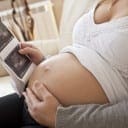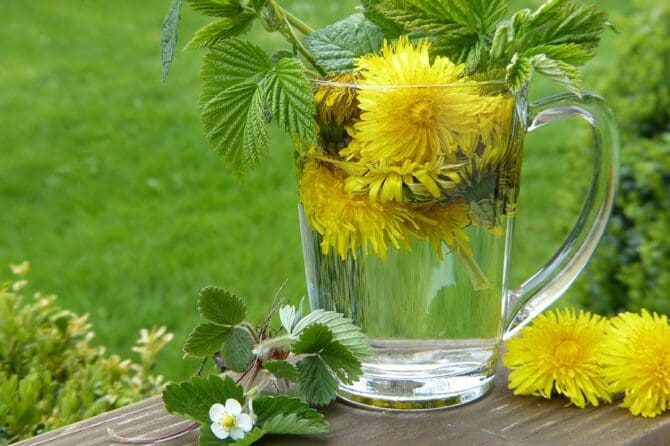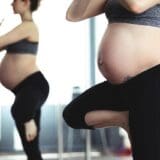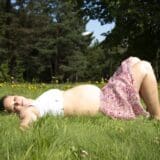Preparing your home for the arrival of a new baby is an exciting and important task. There are several steps you can take to ensure that your home is safe, comfortable, and ready to welcome your little one. In this article, we will provide you with tips and advice on how to prepare your home for a new baby.
One of the first things you should do is create a nursery. This is a dedicated space for the baby where they can sleep, play, and be changed. Set up a crib with a comfortable mattress and bedding, a changing table with all the necessary supplies, and storage for clothes, diapers, and other baby essentials. Consider adding a rocking chair or glider for those late-night feedings.
Next, it’s important to baby-proof your home. Babies are curious and mobile, so it’s essential to identify potential hazards and take steps to make your home safe. Start by securing heavy furniture to the wall to prevent tipping. Use anchors or brackets to ensure that bookshelves, dressers, and other furniture cannot be pulled over by a curious baby. Cover electrical outlets with outlet covers to prevent the baby from sticking their fingers or objects into them. Install safety gates at the top and bottom of stairs and in doorways to restrict access to certain areas of the house.
In addition to securing furniture and covering electrical outlets, it’s crucial to remove choking hazards from your home. Babies put everything in their mouths, so it’s essential to clear the home of small objects that could pose a choking risk. Keep small toys, coins, buttons, and other small items out of reach. Regularly inspect the floor and other surfaces for any potential hazards.
Another important step in preparing your home for a new baby is to lock cabinets and drawers. Install childproof locks on cabinets and drawers to keep dangerous items out of the baby’s reach. This includes cleaning supplies, medications, sharp objects, and any other potentially harmful substances. Make sure to secure cabinets and drawers in the kitchen, bathroom, and any other areas where hazardous items may be stored.
Aside from baby-proofing, it’s also essential to stock up on baby essentials before the baby arrives. Make sure you have an ample supply of diapers, wipes, bottles, formula, and any other items your baby will need. Create a designated area to store and organize baby gear, such as strollers, car seats, and baby carriers. Having everything easily accessible and organized will make your life much easier once the baby arrives.
Lastly, set up a feeding station in your home. This should be a comfortable and convenient space for feeding the baby. Consider investing in a rocking chair or glider where you can sit and feed the baby comfortably. Have a side table nearby to hold supplies like bottles, burp cloths, and bibs. Creating a cozy and functional feeding station will make feeding time more enjoyable for both you and your baby.
By following these tips and advice, you can ensure that your home is well-prepared for the arrival of a new baby. Remember to create a nursery, baby-proof your home, remove choking hazards, lock cabinets and drawers, stock up on essentials, organize baby gear, and set up a feeding station. Taking these steps will help create a safe, comfortable, and welcoming environment for your little one.
Create a Nursery
When preparing for the arrival of a new baby, one of the first things you’ll want to do is create a nursery. This dedicated space will serve as the baby’s haven, providing comfort and convenience for both you and your little one. Here are some essential items you should consider including:
- Crib: A crib is the centerpiece of any nursery. Make sure to choose a safe and sturdy crib that meets the latest safety standards. You can also opt for a convertible crib that can be transformed into a toddler bed as your baby grows.
- Changing table: A changing table is a must-have for quick and easy diaper changes. Look for a changing table with ample storage space for diapers, wipes, and other essentials.
- Storage: Babies come with a lot of stuff, so it’s important to have plenty of storage options. Consider investing in a dresser or shelves to keep clothes, blankets, and toys organized and easily accessible.
Creating a nursery is not just about functionality, but also about creating a soothing and inviting atmosphere. Choose soft colors, gentle lighting, and cozy textiles to make the space feel warm and comforting. Remember, this is where you and your baby will spend a lot of time bonding and creating precious memories.
Baby-Proof Your Home
Preparing your home for the arrival of a new baby is an exciting and important task. One of the most crucial aspects of this preparation is baby-proofing your home to ensure a safe environment for your curious and mobile little one. By identifying potential hazards and taking the necessary steps, you can create a secure space where your baby can explore and play without any worries.
First and foremost, it is essential to secure your furniture. Babies love to grab onto things and pull themselves up, so it’s crucial to anchor heavy furniture, such as bookshelves and dressers, to the wall. This will prevent any tipping accidents and ensure that the furniture is stable and safe for your little one. Use furniture straps or brackets to secure them firmly to the wall.
Another important step in baby-proofing your home is covering electrical outlets. Babies are naturally curious and may try to stick their fingers or objects into outlets, which can be extremely dangerous. Install outlet covers or safety plugs to prevent any accidents. These covers are inexpensive and easy to install, providing a simple yet effective solution.
Safety gates are also a must-have when baby-proofing your home. Place safety gates at the top and bottom of stairs and in doorways to restrict access to certain areas. This will prevent your baby from wandering into potentially hazardous areas, such as the kitchen or bathroom. Make sure the gates are securely installed and meet safety standards.
Removing choking hazards is another critical step in making your home safe for your baby. Take the time to clear your home of small objects that could pose a choking risk. Keep an eye out for items such as coins, small toys, buttons, and even certain household plants. It’s always better to be safe than sorry when it comes to your baby’s well-being.
Additionally, it’s essential to lock cabinets and drawers that contain potentially dangerous items. Install childproof locks on these storage spaces to keep harmful substances, sharp objects, or fragile items out of your baby’s reach. This will give you peace of mind knowing that your little one won’t accidentally get into something they shouldn’t.
Baby-proofing your home is an ongoing process as your baby grows and becomes more mobile. Regularly reassess your home for any new potential hazards and make the necessary adjustments. By taking these proactive steps, you can create a safe and secure environment where your baby can thrive and explore without unnecessary risks.
Secure Furniture
When preparing your home for a new baby, one important step is to secure your furniture to ensure the safety of your little one. Heavy furniture, such as dressers, bookshelves, and TV stands, can pose a serious risk if not properly anchored to the wall. The last thing you want is for a piece of furniture to tip over and potentially harm your baby.
To secure your furniture, start by identifying the pieces that are at risk of tipping. These are typically taller and top-heavy items. Once you’ve identified the furniture that needs to be secured, you can use furniture straps or brackets to anchor them to the wall. These can be easily found at your local hardware store or online. Follow the manufacturer’s instructions for installation, ensuring that the furniture is securely attached to the wall.
It’s also important to make sure that any items on top of the furniture are secure. For example, if you have a changing table with a diaper stacker or other items on top, make sure they are stable and won’t easily fall off. Consider using adhesive putty or non-slip mats to keep items in place.
By taking the time to secure your furniture, you can have peace of mind knowing that your baby is safe in their environment. Remember, it’s always better to be safe than sorry when it comes to the well-being of your little one.
Cover Electrical Outlets
When preparing your home for a new baby, it is crucial to take steps to ensure their safety. One important aspect of baby-proofing is covering electrical outlets. Babies are naturally curious and love to explore their surroundings, which can put them at risk of sticking their fingers or objects into outlets.
To prevent any accidents, it is recommended to install outlet covers throughout your home. These covers act as a protective barrier, making it impossible for the baby to access the electrical outlets. They are easy to install and can be found at most baby supply stores or online retailers.
When choosing outlet covers, opt for ones that are difficult for a baby to remove but easy for adults to access when needed. There are various types available, such as sliding covers or covers that require a plug to be inserted to open the outlet. Consider your specific needs and preferences when selecting the right type of outlet covers for your home.
It is also a good idea to cover outlets that are within the baby’s reach, even if they are in less frequently used areas of the house. Babies are quick learners and can move around faster than you might expect. By covering all outlets, you can have peace of mind knowing that your little one is safe from potential electrical hazards.
Remember, electrical outlets can be found not only on walls but also on power strips and extension cords. Make sure to cover all types of outlets to ensure maximum safety for your baby. By taking this simple and proactive step, you are creating a secure environment for your new arrival.
Install Safety Gates
Install Safety Gates
When preparing your home for a new baby, one important step is to install safety gates. Safety gates serve as barriers to restrict access to certain areas, ensuring the baby’s safety. They are particularly crucial at the top and bottom of stairs and in doorways.
By placing safety gates at the top and bottom of stairs, you can prevent your little explorer from climbing up or down the stairs unsupervised. This is especially important as babies start to crawl and explore their surroundings. Safety gates provide a physical barrier that keeps them safe and secure.
In addition to stairs, safety gates should also be installed in doorways to prevent the baby from entering rooms or areas that may pose a potential danger. For example, you may want to restrict access to the kitchen, where there are sharp objects and hot surfaces. By installing a safety gate, you can create a safe space for your baby to play and explore while keeping them away from potential hazards.
When choosing safety gates, opt for ones that are sturdy and secure. Look for gates that are specifically designed for use with babies and have a reliable locking mechanism. It’s important to follow the manufacturer’s instructions for installation to ensure the gate is properly secured.
Remember, safety gates are not meant to replace adult supervision. While they provide an additional layer of protection, it’s still essential to keep a close eye on your baby at all times. Regularly check the gates to ensure they are in good condition and functioning properly.
By installing safety gates, you can create a safe and secure environment for your baby, allowing them to explore and play while giving you peace of mind.
Remove Choking Hazards
When preparing your home for the arrival of a new baby, one of the most important steps is to remove any choking hazards. Babies are naturally curious and love to explore their surroundings by putting things in their mouths. It’s crucial to create a safe environment by clearing the home of small objects that could pose a choking risk.
Start by going through each room in your house and carefully inspecting for potential hazards. Look for small items like coins, buttons, beads, or any other small objects that could easily fit into a baby’s mouth. These objects should be stored out of reach or removed from the home entirely. It’s better to be safe than sorry.
To help you keep track of potential choking hazards, you can create a checklist or use a table to list down the items that need to be removed or secured. This way, you can systematically go through each room and ensure that you’ve taken care of all the potential risks.
Additionally, be mindful of items that may not seem like choking hazards at first glance. For example, be cautious with small parts of toys, buttons on clothing, or even loose screws or nails that may be within reach of the baby. These seemingly harmless objects can quickly become dangerous if swallowed.
Another important step is to educate yourself and other family members about what items should be kept away from the baby. By raising awareness and ensuring everyone is on the same page, you can create a safer environment for your little one.
Remember, babies are naturally curious and tend to explore their surroundings with their mouths. It’s crucial to remove any potential choking hazards to keep your baby safe. By taking the time to clear your home of small objects and being vigilant about potential risks, you can create a safe and secure environment for your new arrival.
Lock Cabinets and Drawers
Lock Cabinets and Drawers
When preparing your home for a new baby, it is crucial to ensure their safety by installing childproof locks on cabinets and drawers. Babies are naturally curious and love exploring their surroundings, which means they can easily get into places they shouldn’t. By securing cabinets and drawers, you can prevent them from accessing dangerous items and potentially harming themselves.
To effectively childproof your cabinets and drawers, there are various types of locks available in the market. One popular option is magnetic locks, which use magnets to secure the doors and drawers. These locks are hidden from plain sight, making them aesthetically pleasing while still providing the necessary safety measures. Another option is adhesive locks, which are easy to install and remove when no longer needed.
Additionally, consider organizing your cabinets and drawers in a way that keeps hazardous items out of reach. Store cleaning products, sharp objects, and medications in high cabinets or drawers that are inaccessible to the baby. Keep everyday items like pots and pans, plastic containers, and baby-friendly utensils within easy reach for convenience.
Remember, as your baby grows and becomes more mobile, they will develop the ability to open cabinets and drawers. Regularly check the locks to ensure they are in proper working condition and make any necessary adjustments. By taking these steps, you can create a safe environment for your little one to explore and grow without the risk of encountering dangerous items.
Stock Up on Essentials
Stocking up on essentials is an important step in preparing your home for a new baby. It’s essential to ensure that you have all the necessary baby supplies before the baby arrives. Here are some key items to include on your shopping list:
- Diapers: Stock up on a variety of sizes, as babies grow quickly.
- Wipes: These are essential for keeping your baby clean and fresh.
- Bottles: If you plan on bottle-feeding, make sure you have an adequate supply of bottles and nipples.
- Formula: If you’re not breastfeeding, make sure you have enough formula to last at least a few weeks.
In addition to these essentials, there are a few other items that you may want to consider:
- Breast pump: If you plan on breastfeeding, a breast pump can be a helpful tool.
- Breast pads: These can be used to absorb any leaks and keep you comfortable.
- Nursing pillow: A nursing pillow can provide support and make breastfeeding more comfortable.
- Baby monitor: This can help you keep an eye on your baby when they are sleeping in another room.
Creating a checklist and gradually purchasing these items can help you spread out the cost and ensure that you have everything you need before the baby arrives. It’s also a good idea to have some items on hand for emergencies, such as extra diapers and wipes, in case you run out unexpectedly. By stocking up on essentials, you can feel confident and prepared for your new arrival.
Organize Baby Gear
When preparing for the arrival of a new baby, it’s important to have a designated area to store and organize all the necessary baby gear. This will not only help keep your home tidy and clutter-free, but it will also make it easier for you to find and access the items you need when taking care of your little one.
To organize baby gear effectively, consider creating a dedicated space in your home where you can store items like strollers, car seats, and baby carriers. This could be a closet, a corner of the nursery, or even a separate room if you have the space. The key is to have a designated area where everything can be easily accessed and put away.
One way to organize baby gear is by using storage solutions such as shelves, bins, and hooks. You can install shelves on the wall to store items like baby carriers and diaper bags, use bins or baskets to keep smaller items like toys and pacifiers organized, and hang hooks to hang strollers or car seats. This will not only keep everything in its place but also make it visually appealing and easy to find.
Another helpful tip is to label and categorize your baby gear. Use labels or tags to identify what each item is and where it belongs. For example, you can label a bin as “toys” or “diapers” so you know exactly what is inside. Categorizing items will make it easier for you or anyone else helping you to find what you need quickly.
Lastly, regularly declutter and reorganize your baby gear. As your baby grows, you may find that certain items are no longer needed or that new items need to be added. Take the time to go through your baby gear periodically and donate or store items that are no longer necessary. This will help keep your storage area tidy and ensure that you have space for new items as needed.
By having a designated area to store and organize baby gear, you can ensure that everything is easily accessible and in its place. This will not only make your life easier but also create a more organized and efficient home environment for you and your little one.
Set Up a Feeding Station
When it comes to feeding your baby, having a dedicated and well-equipped feeding station can make all the difference. Creating a comfortable and convenient space for feeding not only ensures that you and your baby are comfortable during feeding sessions, but it also helps to keep all the necessary supplies within reach.
One essential piece of furniture for your feeding station is a rocking chair or glider. These chairs provide a soothing motion that can help calm and relax both you and your baby during feeding time. Look for a chair that is comfortable and provides adequate support for your back and arms. You may also consider adding a cushion or pillow for extra comfort.
In addition to the chair, it’s important to have a side table next to your feeding station. This table can be used to hold essential supplies such as burp cloths, bibs, bottles, and formula. Having these items within arm’s reach saves you from having to constantly get up and search for them during feeding sessions.
To keep your feeding station organized, consider using a small storage bin or basket to hold all the necessary supplies. This will help to keep everything in one place and prevent clutter. You can also use dividers or compartments within the storage bin to further organize items like pacifiers, nipple shields, and breast pads.
Lastly, don’t forget to create a cozy and calming atmosphere in your feeding station. Soft lighting, soothing music, and a pleasant scent can all contribute to a relaxing feeding experience for both you and your baby. Consider using a table lamp with a dimmer switch to adjust the lighting to your preference.
Remember, the feeding station is not only a place for nourishment but also a bonding opportunity between you and your baby. By creating a comfortable and convenient space, you can make feeding time a special and enjoyable experience for both of you.
Frequently Asked Questions
- 1. How should I set up the nursery for my baby?
To create a nursery for your baby, you’ll need a crib, changing table, and storage for clothes and supplies. Make sure to arrange the furniture in a safe and convenient layout. Keep the crib away from windows and cords, and ensure that the changing table is sturdy and well-equipped. Use storage solutions like bins or shelves to keep everything organized and easily accessible.
- 2. What steps should I take to baby-proof my home?
Start by securing heavy furniture to the wall to prevent tipping. Install outlet covers to protect your baby from electrical hazards. Place safety gates at the top and bottom of stairs and in doorways to restrict access to certain areas. Remove any small objects that could be choking hazards, and install childproof locks on cabinets and drawers to keep dangerous items out of reach.
- 3. How can I ensure the safety of my baby around the house?
Aside from baby-proofing, always supervise your baby and be aware of their surroundings. Regularly check for potential hazards and address them promptly. Keep cleaning supplies and medications out of reach, and be cautious with hot liquids and sharp objects. It’s also important to educate yourself on first aid and CPR in case of emergencies.
- 4. What essential baby supplies should I stock up on?
Prior to your baby’s arrival, make sure you have an ample supply of diapers, wipes, bottles, formula (if applicable), and any other specific items your baby may need. It’s also a good idea to have extra clothes, blankets, and burp cloths on hand. Consider creating a checklist to ensure you have all the necessary supplies before the baby arrives.
- 5. How should I organize baby gear?
Designate a specific area in your home to store and organize baby items such as strollers, car seats, and baby carriers. Use hooks, shelves, or bins to keep everything tidy and easily accessible. Consider labeling or categorizing items to make it even more convenient for you and your partner to find what you need when you need it.
- 6. What should I include in a feeding station?
For a comfortable and convenient feeding station, have a rocking chair or glider where you can comfortably sit while feeding your baby. Place a side table nearby to hold supplies like bottles, burp cloths, and a small lamp for nighttime feedings. Make sure the area is well-lit and cozy, creating a soothing environment for both you and your baby.











